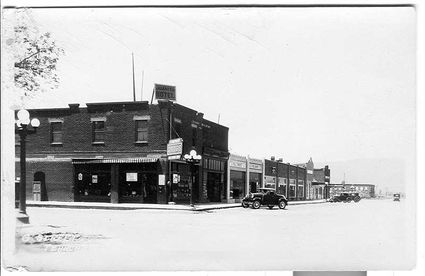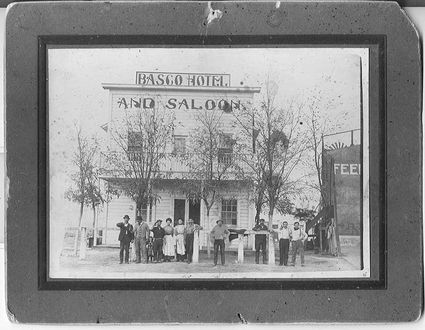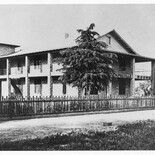Basques find a home in Tehachapi

After establishing himself and later opening the Iriart Hotel, Iriart built this substantial brick building on the corner of G Street (now known as Tehachapi Blvd.) and Green Street, which housed a pharmacy, the Juanita Hotel and Henry's Café.
Research for this article includes information from the book, "Basques to Bakersfield", by Mary Paquette, published in 1982 by the Kern County Historical Society and original materials in the Tehachapi Heritage League archives.
The Basques, coming from the mountainous areas of the Pyrenees in both Spain and France, came by the thousands to America, many finding a home in various parts of the western United States. The mountains surrounding Tehachapi reminded them of the Pyrenees and so a foothold was established by the first Basques arrivals. Many came as sheepherders and gradually started their own flocks. As they prospered, they undertook ventures into hotels, restaurants, and other businesses that would grow with the help of family, friends and newer immigrants. Eventually the Bakersfield area attracted the highlanders and today there is barely a trace of the once thriving Basque culture in Tehachapi.
How is it that Tehachapi became such a center of the Basque culture in the late 1880s and early 1900s? A look back at Basque history gives us some answers. Basque sailors, well renowned for their abilities at sea, were part of the crew that sailed with Christopher Columbus and were among the first to set foot on the newly discovered continent. Early gold miners from the Basque Country arrived after gold was discovered in California in 1848. By 1886 there were 2,000 Basques in the Los Angeles area.
A major study of Basques in the New World show that 84% of eighteen-year-olds born in the Basque Country between 1876 and 1879 left to seek a better life elsewhere. A major reason being that the small family farms were often too small to be divided between the large families of 8 to 10 children that each generation produced.
The early immigration practices were started by the large Nevada ranchers who recruited in the Basque Country and provided the funds for immigrants to come to America and gave them jobs when they arrived. As these workers prospered and moved on, they established businesses and brought over more family and friends to assist. It has been said that the many Basque hotels couldn't keep maids because the young women were quickly betrothed to the many Basque bachelors longing for a wife and family.
As Basques immigrated to Kern County and the San Joaquin Valley in search of employment and to establish farms and ranches, Basques already in the California and Nevada area migrated in large numbers, lured by the promise of large plots of land and favorable growing conditions. Poorer immigrants initially worked as sheepherders and wood cutters. As with most groups of immigrants, the Basques preferred to marry other Basques and the strong family bonds aided the growth of their businesses as they grew.
Iribane, Errecart, Iriart, Vidaillet, Martinto, Sola, Errea, Amestoy, Laffargue, Capedeville... these are a few of the well-known names in the Tehachapi area in its early days. They were associated with families that many times arrived with little to their names but who established their families as contributing members of the community and, in some cases, as business owners who built comfortable lives for their families and provided employment to others.
A walk through the small town clustered around the Southern Pacific railway depot on G Street, usually referred to at that time as Main Street later known as Tehachapi Blvd., would reveal the influence of the Basque business leaders in Tehachapi at that time. At various times you could see the Iriart Hotel, the Franco American Hotel the Cesmat Hotel, the Commercial Hotel, the handball court, Basses Pyrenees Hotel, the Capedeville Hotel, Joe Sola's Barber Shop, Iriart's Union Oil Service Station, the Tehachapi Hotel (referred to as "The French Hotel"), and other businesses.

This photo shows the staff of the Basco Hotel on H Street across the tracks from the Southern Pacific Depot. To the right is the handball court. The hotel was originally the Iriart Hotel.
One Spanish Basque family that came and remained was the Errea family. Jose Errea was born in Olondres, Spain. After completing his military service he came to California and for ten years worked as a wood cutter for the Summit Lime Company. He returned to his homeland when it came time to find a wife and settle down. In 1906, with his new bride Melitona Redin, he returned to America with the intention of settling in San Francisco. Arriving in New York, he heard of the great San Francisco earthquake of 1906 and so he headed to familiar ground in Tehachapi. They lived at the site of the lime kiln at the Summit Limestone Mine until their children were of school age and at that time moved into Tehachapi, about 1917.
They lived in a house owned by Mrs. Errea's uncle, Antonio Redin, a house moved on log rollers pulled by mules from the old town site of Williamsburg, about 4.5 miles away. The house was moved around 1900 on log rollers by Louis Vidaillet, another Basque immigrant and owner of a blacksmith shop.
After the death of the elder Erreas, two of their offspring, Grace and Martin, lived in the house until their passing. Today it is known as the Errea House Museum, dedicated to portraying the small town lifestyle of rural America in the 1900 to 1930 era. It is one of the last remaining signs of the once flourishing Basque community in the Tehachapi Mountains.
Errea House is located at 311 Green Street. For more information contact
(661) 822-8152.








